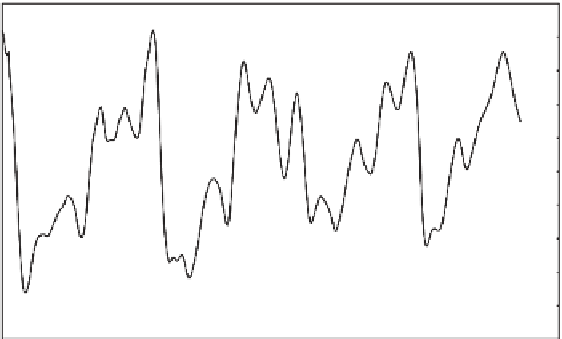Geoscience Reference
In-Depth Information
−
2.5
−
410
+4
°
C
−
2.0
−
420
Less ice
−
1.5
−
−
430
0
°
C
1.0
−
440
−
0.5
−
450
0.0
−
4
°
C
−
460
0.5
1.0
470
−
−
480
1.5
−
8
°
C
−
490
δ
D
Antarctic ice core
2.0
LGM
More ice
δ
18
O
marine carbonate
−
500
2.5
0
50
100
150
200
250
300
350
400
450
Age (ka)
Figure 9.2
18
O (relative to PDB standard) in the carbonate of benthic foraminifera (SPECMAP
database). Increased storage of water in polar ice during glacial periods increases the
18
Oisotope
concentration of the ocean. The
Fluctuation of
δ
18
O curve follows (although with a small time lag) the
temperature curve deduced from the
δ
D values measured in the Vostok ice core in Antarctica
(Petit
et al.
,
1999
)
. The horizontal lines show the temperature shifts in the polar region deduced
from the
δ
last glacial maximum. The periodic aspect of fluctuations is
caused by astronomical forcing (Milankovic cycles).
δ
Dvaluesinice.LGM
=
Lower average temperatures during the ice ages are explained by the astronomical mod-
ulation of insolation and its amplification by a lower level of CO
2
in the atmosphere, and
therefore a weaker greenhouse effect. Plotting
P
CO
2
vs.
CO
2
for different pH values for
decreases
CO
2
, makes the ocean less acidic and therefore enhances carbonate preserva-
tion, which is reflected by a deepening of the CCD. The intervals during which limestone
is abundant at great depths are cold periods.
The short-term variability in the isotopic composition of oxygen recorded by foramini-
fera is essentially indicative of the abundance of polar ice: temperatures at high latitudes
vary periodically with orbital forcing, especially the precession of the equinoxes (19 000
and 23 000 years), the variation in the inclination (obliquity) of the Earth's axis of rotation
on the ecliptic (41 000 years), and the eccentricity of the Earth's orbit around the Sun
(100 000 years). These are the famous Milankovic cycles regulating the alternating pattern
9.1.2 Mesozoic and Cenozoic climatic trends
In contrast, the long-term variability of oxygen isotopes in benthic (deep-sea) foraminifera
reveals the secular cooling of the deep ocean waters. The temperatures recorded by the
δ

























































































































































































